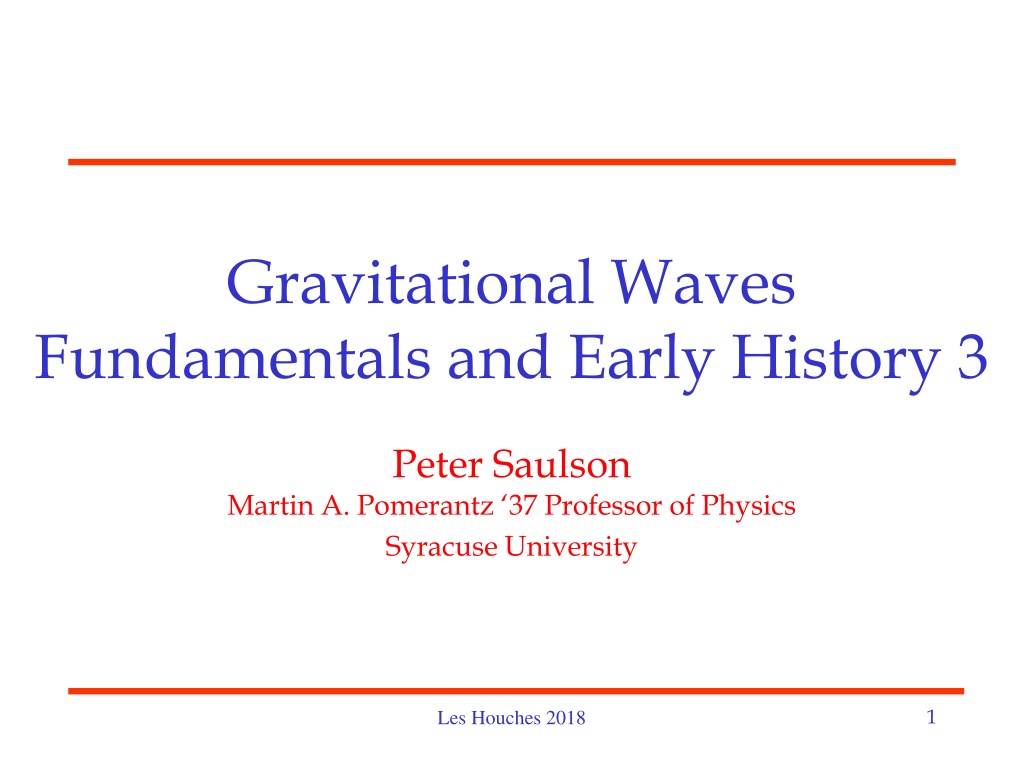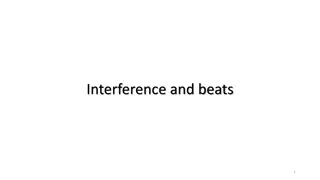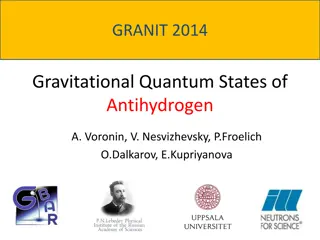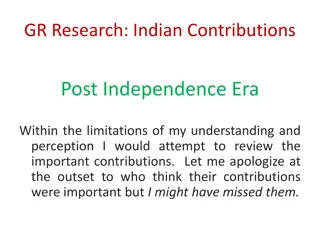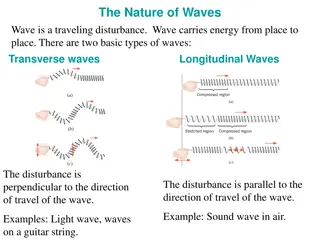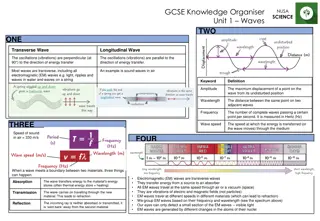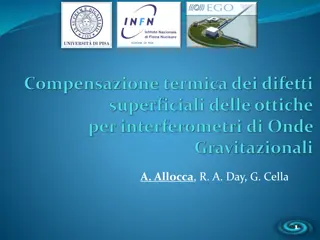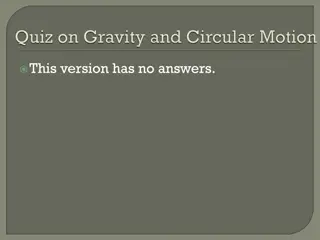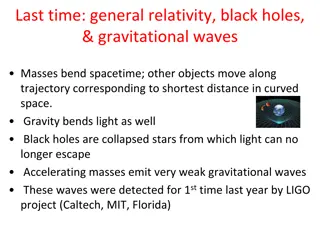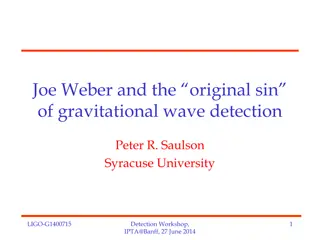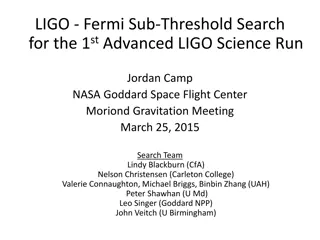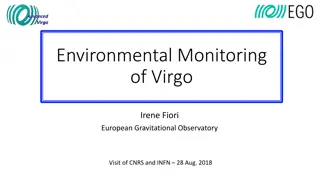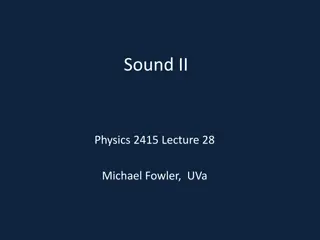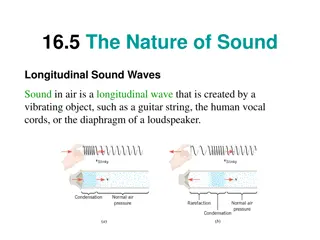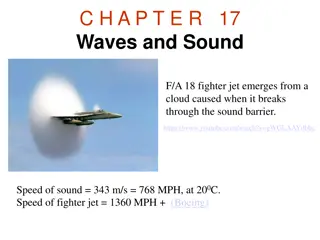Understanding Gravitational Waves: Basics and Detection Challenges
Exploring gravitational waves fundamentals, early history, and challenges in detection. Covers topics like interpreting noise power spectrum, shot noise in interferometers, radiation pressure, and quantum limits. Illustrates the importance of noise spectrum analysis and mathematical operations in understanding signal detection. Provides resources for learning about interferometer workings and applied mathematics.
Download Presentation

Please find below an Image/Link to download the presentation.
The content on the website is provided AS IS for your information and personal use only. It may not be sold, licensed, or shared on other websites without obtaining consent from the author. Download presentation by click this link. If you encounter any issues during the download, it is possible that the publisher has removed the file from their server.
E N D
Presentation Transcript
Gravitational Waves Fundamentals and Early History 3 Peter Saulson Martin A. Pomerantz 37 Professor of Physics Syracuse University 1 Les Houches 2018
Outline for Day 3 1. Interpreting the noise power spectrum (applied math for time series) 2. Shot noise in an interferometer 3. Radiation pressure and the quantum limit 2 Les Houches 2018
Gravitational wave detection does work! All of these challenges sound impossible. And yet, all of them can be met. Detectors have now seen signals whose peak strain is 10-21 with signal-to-noise ratios of more than 20. But how is it possible? 3 Les Houches 2018
If you really want to learn the basics of how interferometers work read the (2nd edition of) the book that I wrote for beginners. http://www.worldscientific.com /worldscibooks/10.1142/10116 4 Les Houches 2018
Noise spectrum of aLIGO at the time GW150914 was found 5 Les Houches 2018
How can we read/interpret a noise power spectrum? If you want to understand what is encoded in a graph of the power spectrum, you need to be in command of a fair amount of applied mathematics . Then, you can read a great deal of applied physics from the power spectrum. Firstly, I ll review a set of useful mathematical operations on time series. Most importantly, trying to build intuition 6 Les Houches 2018
Fundamental mathematical object: the time seriesx(t) Many interesting things appear as a single- valued function of time, or a time series. Examples: A deterministic function of time, such as the gravitational wave strain h(t) from, say, a coalescence of two black holes. A random function of time, such as the output of an interferometer when no signal is present. A mixture of the two, say when the output of an interferometer contains a signal. Different operations are useful in different cases. Les Houches 2018 7
The Fourier transform The Fourier transform X(f) of x(t) is defined as 2 1 2 = i ft ( ) ( ) X f x t e dt This measures the amount of a sine and cosine of each frequency f that it takes to build up the function x(t). Most useful when x(t) is a deterministic function. But used all over the place Defines the relation between the time domain and the frequency domain. 8 Les Houches 2018
The cross-correlation If we have two time series, x1(t) and x2(t), we can form the cross-correlation ( ) x x ( ) ( x t )dt + x t 1 2 1 2 This measures the extent to which the shape of one time series matches the shape of the other time series, as a function of the time-shift between them. Often used in a situation in which one time series is deterministic and the other is random. 9 Les Houches 2018
How to find weak signals in strong noise Look for something that looks more like the signal than noise, at suspiciously large level. 5 s1(t) 0 -5 0 10 20 30 40 50 60 70 80 90 100 5 s2(t+tau) 0 -5 0 10 20 30 40 50 60 70 80 90 100 100 xcorr(s1,s2) 0 -100 0 10 20 30 40 50 60 70 80 90 100 Time t 10 Les Houches 2018
The autocorrelation We call the cross-correlation of a time series x(t) with itself the autocorrelation ( ) ( ) ( x x x )dt + t x t This gives a measure of the time scale over which the time series varies, and well as any scales on which it repeats. Used in as many and varied cases as the Fourier transform. 11 Les Houches 2018
The power spectrum If we take the Fourier transform of the auto-correlation of a time series, we form the power spectrum ( ) 2 1 d f ( 2 i ) S f x x e x Like the Fourier transform, it measures the admixture of sinusoids of all frequencies f that make up the time series x(t); however, it throws away the phase information (sines vs. cosines.) Thus, most often used on random time series. 12 Les Houches 2018
The single-sided power spectrum The power spectrum Sx(f) refers to exponentials of both positive and negative frequencies. Experimentalists usually prefer to think in terms of just positive frequencies, so there is a single-sided power spectrum if ), ( 2 ) ( 2 0 x f S f f x otherwise , 0 True to form, I like this version of the power spectrum best. 13 Les Houches 2018
The periodogram Consider a section (with duration T) of time series x(t), which has Fourier transform X(f). The periodogram of x(t) is given by Theorem: In the limit that T goes to infinity, the expectation value of the periodogram of x(t) is equal to the power spectrum Sx(f). This is another reminder that the power spectrum of x(t)measures the amount of sinusoids of frequency f in x(t). This is also the way that power spectra are usually calculated. 2T ( ) / . X f 14 Les Houches 2018
More on interpretation of the power spectrum Conceptual way of measuring the power spectrum: Apply signal x(t) to a bank of bandpass filters, each with 1 Hz pass band width, band centers at each integer frequency. Compute the mean-square value of the output of each filter, and display as a function of f. Theorem: If you sum up (i.e., integrate) all outputs of all filters, then you recover the mean-square value of x(t). Makes sense because the units of the power spectrum are [units of x]2/Hz. 15 Les Houches 2018
The amplitude spectral density Experimenters have limited minds, and find it easier to get their minds around something that doesn t square the units of x(t). So we often use the amplitude spectral density x f x ) ( ( ) f 2 Its units are [units of x(t)]/Hz1/2. Note though that we ve avoided m2, say, but picked up instead the units of /Hz1/2 This serves as a reminder to switch back to the true power spectrum before doing an integral. 16 Les Houches 2018
Describing an interferometers sensitivity Often, we quote an interferometer s sensitivity in terms of the root-mean-square of the noise output (through an appropriate filter. For example, we could say that Advanced LIGO s sensitivity to binary inspirals was about hrms ~ 10-22. How can we link that to the power spectrum or amplitude spectral density? 17 Les Houches 2018
Describing an interferometers sensitivity Advanced LIGO s sensitivity to signals like GW150914 was about hrms ~ 10-22. That means that the standard deviation of strain measurements averaged over a 10 msec duration had a value of 10-22. Let s convert this spec to power spectrum language ) ( Hz 50 ( 10 ) . 150 Hz 2 = 2 22 h f df This means we want a noise amplitude spectral density near 100 Hz of ) Hz 100 ( = f h = 23 10 / Hz . 18 Les Houches 2018
Re-expressing strain noise as displacement noise What spectrum of noise in the mirrors position is consistent with this goal? We ll have four key mirrors (two in each arm to make the Fabry-Perot cavities, see later in this lecture.) If their displacement noises are incoherent, they add in quadrature. The net result is ) ( f hdisp = 2 L ( ). x f Thus, we need x(f) = 2 * 10-20 m/Hz1/2. 19 Les Houches 2018
Noise spectrum of aLIGO at the time GW150914 was found 20 Les Houches 2018
Shot noise Recall that an interferometer is an arm-length- difference-to-brightness transducer. That means that what determines our ability to measure a weak gravitational wave is the competition between a small brightness change (from a weak gravitational wave) and the error in our measurements of brightness at the output port. With care, we can be limited by quantum fluctuations in the light itself: shot noise. 21 Les Houches 2018
Interferometer output vs. arm length difference 1 0.9 0.8 0.7 0.6 Output power Power 0.5 0.4 0.3 0.2 0.1 0 -1.5 -1 -0.5 0 0.5 1 1.5 -5 Optical Path Difference, modulo n wavelengths (cm) phase difference (cycles) x 10 22 Les Houches 2018
Firstly, make the signal big: Light should travel for ~ GW period LIGO has arms that are only 4 km long, for a round trip travel time of 27 microseconds. This is optimal for a signal at 18.75 kHz! If our target signal had a frequency of 200 Hz instead, we d benefit from the light spending ~ 100 round trips in the arms. 23 Les Houches 2018
The Advanced Michelson interferometer 24 Les Houches 2018
Michelson hired Morley to add beam folding to the original ifo design In the early 1880s, Michelson built an initial Michelson interferometer. But it didn t have sufficient sensitivity to detect the ether drift. By sending the light through four round trips across the diagonal of the optical table, the advanced Michelson interferometer was able to rule out the ether and pave the way for relativity. 25 Les Houches 2018
Herriott delay line: An early idea for achieving multiple round trips 26 Les Houches 2018
A much cleverer way: resonant Fabry-Perot cavities Light can be trapped between two small mirrors, by properly adjusting the distance between them. Interference does the trapping One (or both) mirrors must have some finite transmission for light to get in and out. Minimum mirror size set by diffraction. 27 Les Houches 2018
Analysis of F-P cavities by Joe Kovalik 28 Les Houches 2018
29 Les Houches 2018
How is a Fabry-Perot cavity like an arm with discrete bounces? Key benefit of multi-pass arm is increasing the phase change due to grav wave c 2 2 NL c = h In a Fabry-Perot cavity, high finesse yields a steep change in phase with respect to length change (incl. due to grav wave!) 30 Les Houches 2018
On resonance we get a very steep dependence of reflected light phase on cavity length 31 Les Houches 2018
Sensitivity of interferometer with on/off readout If we only distinguish between bright and dark output, interferometer wouldn t be very sensitive. ~ optical L / 2 crude h . 1 , m = = ( 4 ) (N 100) L km 12 ~ 10 crude h But we want 10-22 32 Les Houches 2018
The fringe-splitting solution We require ~10 more orders of magnitude in sensitivity, if we hope to see gravitational waves. If so, then we need to know much more than whether we are on the bright or dark point of a fringe. We need to know, to 1 part in 1010, where we are in the fringe. Is this possible? Yes. 33 Les Houches 2018
Working out some rough numbers We need to do 1010times better than on/off measurement. Thus, we require 1020 photons in each 0.01 sec measuring interval. 2 = c Pin N We need about 2 kW of input power. We ll did this with about 20 W of laser power, and the trick called power recycling . 34 Les Houches 2018
Shot noise at 100 Hz is 10-23/Hz1/2, as we expected If the shot noise had been 3x larger, we could not have seen GW150914. (That was the situation for initial LIGO.) 35 Les Houches 2018
To achieve the required sensitivity, need cleverer optics Power Recycled end test mass Michelson Interferometer with Fabry-Perot Arm Cavities Light bounces back and forth along arms about ~100 times Light is recycled about ~50 times input test mass Laser beam splitter signal 36 Les Houches 2018
Power recycling: a huge bonus from using the dark-port operating point When we operate at the dark port, constructively-interfered light leaves the beamsplitter in the direction of the laser. Insert a mirror between the laser and the beamsplitter. (!) When this power recycling mirror is at the right location, it forms a resonant Fabry-Perot cavity, with the rest of the interferometer functioning as the back mirror . It is as if we had a laser with ~ 50 x more power. 37 Les Houches 2018
The design has many refinements. We needed them all to succeed. 38 Les Houches 2018
The Heisenberg microscope: a gedanken experiment 39 Les Houches 2018
The Quantum Limit A powerful microscope is used to see where an atom is located. Photons show where the atom is, but they also kick the atom by an unknown amount. A wide lens gives better position resolution. But a wide lens admits photons from greater angles. Position resolution vs. momentum uncertainty. 40 Les Houches 2018
Quantum limit for LIGO Shot noise resolution / 1 = / x N N N Shot momentum perturbation p rad F N Position error from momentum perturbation xrad N Too much laser power can, under some circumstances, be as bad as too little! More on radiation pressure noise tomorrow. 41 Les Houches 2018
Shot noise at 100 Hz is 10-23/Hz1/2, as we expected If the shot noise had been 3x higher, we could not have seen GW150914. (That was the situation for initial LIGO.) 42 Les Houches 2018
